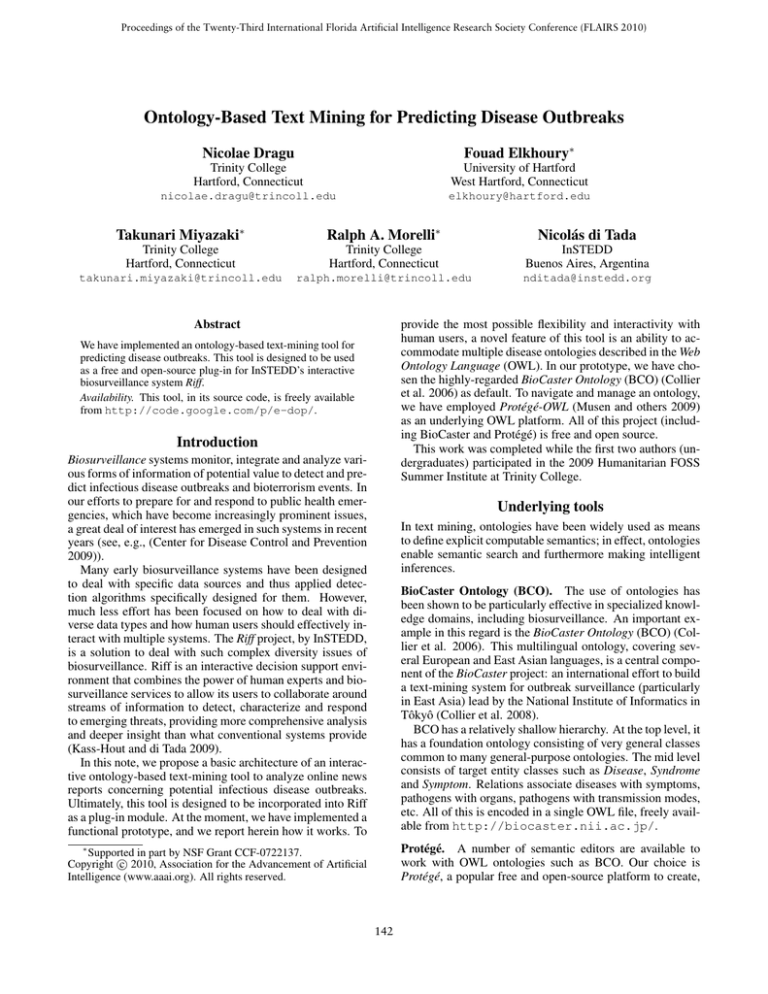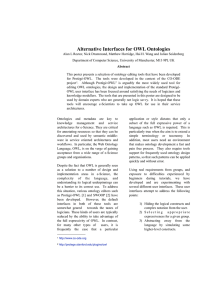
Proceedings of the Twenty-Third International Florida Artificial Intelligence Research Society Conference (FLAIRS 2010)
Ontology-Based Text Mining for Predicting Disease Outbreaks
Nicolae Dragu
Fouad Elkhoury∗
Trinity College
Hartford, Connecticut
University of Hartford
West Hartford, Connecticut
nicolae.dragu@trincoll.edu
elkhoury@hartford.edu
Takunari Miyazaki∗
Ralph A. Morelli∗
Nicolás di Tada
Trinity College
Hartford, Connecticut
Trinity College
Hartford, Connecticut
InSTEDD
Buenos Aires, Argentina
takunari.miyazaki@trincoll.edu
ralph.morelli@trincoll.edu
nditada@instedd.org
provide the most possible flexibility and interactivity with
human users, a novel feature of this tool is an ability to accommodate multiple disease ontologies described in the Web
Ontology Language (OWL). In our prototype, we have chosen the highly-regarded BioCaster Ontology (BCO) (Collier
et al. 2006) as default. To navigate and manage an ontology,
we have employed Protégé-OWL (Musen and others 2009)
as an underlying OWL platform. All of this project (including BioCaster and Protégé) is free and open source.
This work was completed while the first two authors (undergraduates) participated in the 2009 Humanitarian FOSS
Summer Institute at Trinity College.
Abstract
We have implemented an ontology-based text-mining tool for
predicting disease outbreaks. This tool is designed to be used
as a free and open-source plug-in for InSTEDD’s interactive
biosurveillance system Riff.
Availability. This tool, in its source code, is freely available
from http://code.google.com/p/e-dop/.
Introduction
Biosurveillance systems monitor, integrate and analyze various forms of information of potential value to detect and predict infectious disease outbreaks and bioterrorism events. In
our efforts to prepare for and respond to public health emergencies, which have become increasingly prominent issues,
a great deal of interest has emerged in such systems in recent
years (see, e.g., (Center for Disease Control and Prevention
2009)).
Many early biosurveillance systems have been designed
to deal with specific data sources and thus applied detection algorithms specifically designed for them. However,
much less effort has been focused on how to deal with diverse data types and how human users should effectively interact with multiple systems. The Riff project, by InSTEDD,
is a solution to deal with such complex diversity issues of
biosurveillance. Riff is an interactive decision support environment that combines the power of human experts and biosurveillance services to allow its users to collaborate around
streams of information to detect, characterize and respond
to emerging threats, providing more comprehensive analysis
and deeper insight than what conventional systems provide
(Kass-Hout and di Tada 2009).
In this note, we propose a basic architecture of an interactive ontology-based text-mining tool to analyze online news
reports concerning potential infectious disease outbreaks.
Ultimately, this tool is designed to be incorporated into Riff
as a plug-in module. At the moment, we have implemented a
functional prototype, and we report herein how it works. To
Underlying tools
In text mining, ontologies have been widely used as means
to define explicit computable semantics; in effect, ontologies
enable semantic search and furthermore making intelligent
inferences.
BioCaster Ontology (BCO). The use of ontologies has
been shown to be particularly effective in specialized knowledge domains, including biosurveillance. An important example in this regard is the BioCaster Ontology (BCO) (Collier et al. 2006). This multilingual ontology, covering several European and East Asian languages, is a central component of the BioCaster project: an international effort to build
a text-mining system for outbreak surveillance (particularly
in East Asia) lead by the National Institute of Informatics in
Tôkyô (Collier et al. 2008).
BCO has a relatively shallow hierarchy. At the top level, it
has a foundation ontology consisting of very general classes
common to many general-purpose ontologies. The mid level
consists of target entity classes such as Disease, Syndrome
and Symptom. Relations associate diseases with symptoms,
pathogens with organs, pathogens with transmission modes,
etc. All of this is encoded in a single OWL file, freely available from http://biocaster.nii.ac.jp/.
Protégé. A number of semantic editors are available to
work with OWL ontologies such as BCO. Our choice is
Protégé, a popular free and open-source platform to create,
∗
Supported in part by NSF Grant CCF-0722137.
c 2010, Association for the Advancement of Artificial
Copyright Intelligence (www.aaai.org). All rights reserved.
142
visualize and manipulate ontologies in various formats, including OWL (Musen and others 2009). Most importantly,
we have chosen Protégé for its rich functionality, in particular, its ability to support plug-ins and Java-based APIs for
building knowledge-based applications. The choice is also
partly motivated by the fact that BCO itself has been developed by Protégé. To navigate and manage BCO’s OWL file,
we have used the Protégé-OWL editor.
Basic architecture
Our overall goal is to design an ontology-based application
to analyze online news reports concerning potential infectious disease outbreaks. The application’s main task is to
augment the knowledge of a news article by (i) comparing the article’s words against the ontology’s terms and then
(ii) assigning scoring metrics for relevant diseases and syndromes based on the comparison. Ultimately, such metrics
will collectively provide Riff an ability to identify inherent
clustering of seemingly unrelated news reports.
A high-level description of the information flow through
our application is given in Figure 1. The application ingests
plaintext documents (i.e., news articles) one at a time. It also
loads an OWL ontology (e.g., BCO) chosen by the user.
The first step of document analysis is to parse a given document and assign frequencies to each word of the document.
We then match these words against the ontology’s terms that
describe symptoms. For each matched symptom, we navigate through the ontology to determine all diseases and syndromes that have this particular symptom. If a matched
symptom is very specific to a certain disease (resp. syndrome), then it is easy to determine the most likely disease
(resp. syndrome). In most cases, however, a single symptom (such as fever) is associated with many diseases and
syndromes. A disease or syndrome with the most matched
symptoms receives the highest score in the final output.
Simple symptoms are often defined by single words (such
as cough), but there are also many symptoms defined by
phrases (such as stuffy nose). To identify multi-word symptoms, the prototype is capable of performing n-gram matching of input phrases against an ontology’s multi-word terms
(for important related work, see (Conway et al. 2008)).
All of this was implemented in Java using Eclipse.
Figure 1: Overview of information flow
Figure 2: Matching symptoms with diseases and syndromes
References
Center for Disease Control and Prevention. 2009. BioSense.
Atlanta. (http://www.cdc.gov/BioSense/).
Collier, N.; Kawazoe, A.; Jin, L.; Shigematsu, M.; Dien,
D.; Barrero, R. A.; Takeuchi, K.; and Kawtrakul, A. 2006.
A multilingual ontology for infectious disease surveillance:
rationale, design and challenges. Language Resources and
Evaluation 40:405–413.
Collier, N.; Doan, S.; Kawazoe, A.; Goodwin, R. M.; Conway, M.; Tateno, Y.; Ngo, Q.-H.; Dien, D.; Kawtrakul, A.;
Takeuchi, K.; Shigematsu, M.; and Taniguchi, K. 2008. Biocaster: detecting public health rumors with a web-based text
mining system. Bioinformatics 24:2940–2941.
Conway, M.; Doan, S.; Kawazoe, A.; and Collier, N. 2008.
Classifying disease outbreak reports using n-grams and semantic features. In Salakoski, T.; Rebholz-Schuhmann, D.;
and Pyysalo, S., eds., Proceedings of the Third International
Symposium on Semantic Mining in Biomedicine (SMBM
2008), Sept. 1–3, 2008, Turku, 29–36. Turku: Turku Centre
for Computer Science.
Kass-Hout, T., and di Tada, N. 2009. Riff. InSTEDD, Palo
Alto, Calif. (http://instedd.org/evolve/).
Musen, M., et al. 2009. Protégé, ver. 4.0. Stanford Center
for Biomedical Informatics Research, School of Medicine,
Stanford University, Stanford, Calif. (http://protege
.stanford.edu/).
Future work
As the natural starting point, our present prototype focuses
on deriving diseases and syndromes from symptoms found
in given documents. Naturally, BCO also has a rich collection of terms for diseases and syndromes. Our immediate
plan is to extend our implementation to improve our scoring mechanism by also performing direct matching of input
words against an ontology’s disease and syndrome terms.
Another area of improvement is to add an ability to recognize stemmed words (such as coughing). We also wish to
test our implementation with other OWL ontologies.
Acknowledgement
The authors would like to acknowledge Trishan de Lanerolle
for technical assistance and fruitful discussions.
143






